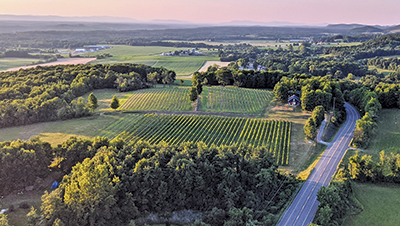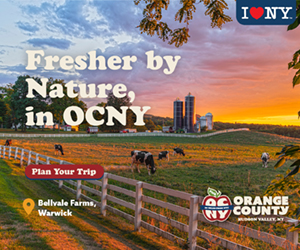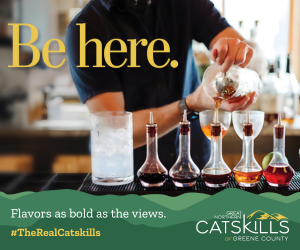The term “sustainable,” unlike “organic” is slightly subjective. When winemakers or farmers label their products as “certified organic,” most consumers know that means that they were grown without chemicals. But it doesn’t necessarily mean that the company is committed to producing them “sustainably,” in a socially and otherwise environmentally sound manner.
Sustainable certification is more variable. Depending on the authorizing body, some amount of herbicide, fungicide, or insecticide spray may be allowed under certain conditions, a commitment to equitable and safe working conditions may be required, and producers may have to promise to lower their energy consumption.
It’s clear that consumers are increasingly drawn to sustainably made products. A recent study shows that the average consumer is willing to pay up to 6% extra for sustainable products. Those items also bear the kind of halo that gets people talking: people are 64% more likely to recommend socially responsible companies to friends, and 63% more likely to try new products from socially responsible companies.*
Winemakers know that in addition to giving consumers what they want, they need to make greener choices if they want to ensure their own future. With increasingly alarming evidence of irreversible climate change—global temperature rise, warming oceans, shrinking ice sheets, glacial retreat, decreased snow cover, sea level rise, to name a handful of the terrifying data on the current state of the planet presented by NASA, sustainable practices are imperative to producers’ bottom line. Across the world, wine harvests have been pushed forward by increasingly warm years. In France, where records have been kept for centuries, harvest dates have flashed forward two weeks since 1980.
In its simplest form, the decision to grow grapes and make wines sustainably is a pledge made by producers to be stewards of the land and community.
In places like California where sustainability practices have been in play in for nearly two decades there are five authorizing bodies overseeing the wine industry alone. New York still has a long way to go in terms of creating a sustainability program with specific benchmarks that both producers and wine lovers can engage with and understand. But, like California and other regions, there has been a growing drumbeat of activity here, especially among individual producers who want to make environmentally and socially responsible choices, whether or not they can “market” those initiatives to the public.
But what does sustainability mean for winemakers?
In its simplest form, the decision to grow grapes and make wines sustainably is a pledge made by producers to be stewards of the land and community, often with a certain amount of wiggle room. So—if say, lantern flies descend—vintners can spray insecticide in a crisis. This allows them the freedom to not have to forgo their entire crop and endanger the economic viability of their brand.
There has also been progress on an institutional level.
The Cornell Cooperative Extension introduced a workbook for winemakers interested in making more responsible ecological choices in 2007. Called VineBALANCE, it includes advice on pest management, irrigation, and best growing practices. Long Island Sustainable Winegrowing, meanwhile, became the first certified sustainable viticulture program on the East Coast in 2012.
In New York, the desire to go green is real, and in places like the Hudson Valley, simply desiring to eliminate all chemicals from the vineyard often isn’t practical. The New York Wine & Grape Foundation (NYWGF) is leading a new initiative to help winemakers learn how they can go green(er) and fight disease pressure and extreme temperatures, without relying on chemicals.
In April, the New York Wine & Grape Foundation announced that it is partnering with the California Winegrowing Alliance on a U.S. Sustainable Winegrowing Summit. But that’s just the beginning of their years-in-the-making commitment to sustainability.
“The goal through the sustainability program is to protect the environment, encourage integrative pest management practices in the vineyard, protect the health of workers and the community, and lower the carbon footprint,” says Sam Filler, who, since his appointment as executive director of the New York Wine & Grape Foundation in 2017, has been working with winemakers across the state to launch a sustainability program that would take the unique climactic and disease challenges of the terroir here into account. “We also believe the program will ultimately increase the profitability of grape production.”
Filler and a cohort of viticulturalists have been figuring out how to establish a statewide certification program, with the goal of not only making New York-made wine more eco-friendly, but transparently communicating its standards to wine lovers who, given the choice, want ecologically responsible libations.
One of the biggest steps they’ve taken is to tap someone to spearhead the entire initiative.
Sustainability specialist Whitney Beaman will serve as New York’s first Sustainability Program Manager. Beaman will lead a pilot program with growers and vintners to study what eco-friendly farming methods have already been adopted by some producers. The goal is to essentially determine what works, and apply it more broadly. The program also aims to ascertain what standards can be strictly benchmarked and which ones may need more flexibility. Marketing materials to educate consumers and a sticker to identify wines hailing from sustainably certified producers are in the works. Soon, consumers who want to support local, sustainable vintners could look for the label and purchase accordingly.
More and more wine drinkers are prioritizing a wine’s environmental impact over its familiarity to their palate.
Hudson Valley growers and winemakers see the program as an important opportunity to communicate their values to wine lovers, who are becoming more and more philosophically invested in buying green. Many local producers, such as Stoutridge and Whitecliff, have been quietly taking ever-more-serious strides toward sustainability for a decade or more.
As enthusiastic consumers of local wine and as residents, we are personally invested in what winemakers are doing in their vineyards and facilities to produce delicious wines, responsibly. We also believe that our readers are just as invested. To understand what’s happening on the ground, we reached out to a few producers for insight into their practices.
A HOLISTIC APPROACH: Stoutridge Vineyard & Distillery
When it was founded in 2001, Stoutridge Vineyard & Distillery, in Marlboro, was designed with the goal of creating truly sustainable products.
“We selected the location and built the space from not just an ecologically responsible perspective, but also with community health in mind,” co-founder Kim Wagner explains. “We built our winery into a hillside, and our wine cellars are underground, which allows us to take advantage of passive geothermal energy. We also use solar-generated electricity and use heat from our stills to warm the building in the winter.”

Whenever there’s a choice between using more or less energy, they opt for the latter. “For example, we use a trolley winch instead of a forklift in the production space, which also makes its safer for workers,” she says. Stoutridge also uses gravity to “filter” and process their wines, instead of conventional pumps or filters.
Anything they don’t produce on the estate for their line of wines, spirits, and liqueurs is sourced locally. What they do grow is not treated with herbicide, though they use fungicide if necessary; they don’t irrigate.
“We try to think of the entire space from a holistic perspective,” Wagner explains. “Everything we plant is native, because that will attract more pollinators and birds, and support biodiversity. We have owl and bat boxes, because they are pest killers. We welcome fox and coyotes, who can keep the estate in balance and control unwanted rodent populations that can eat grapes and damage roots, bark, and shoots. Our parking lot is even made from upcycled asphalt, instead of traditional paving.”
OPEN SPACE: Whitecliff Vineyard
Since 1979, Michael Migliore and Yancey Stanforth-Migliore have been building Whitecliff, one of the largest vineyards in the Hudson Valley with the goal of preserving open space, and continuing the region’s farming legacy. That experimenting blossomed into a commercial winery in 1999, with their first offering; now, they produce about 6,500 cases a year.
“The founding principle was to keep as much land as we could devoted to responsible farming,” Stanforth-Migliore explains. “For us as winegrowers and makers, that comes in a number of different forms.”
Over the years, Migliore, who has a background in chemical engineering, trialed dozens of vitis vinifera and hybrid grapes on their 26 acres, to ascertain which grapes could thrive without requiring pesticides or herbicides, while still garnering serious critical acclaim.
“He wanted Hudson Valley wine to be taken seriously, but he wanted the wines to be made responsibly,” she explains. The winery now regularly earns accolades from critics; recently, their 2019 Pinot Noir received 92 points from Wine Enthusiast. “We farm with biodynamic principles in mind. We prioritize water quality, we produce vegan wines, we recycle everything we can, we serve only locally produced food in the tasting room. A decade ago, we built a geothermal wine production facility, which optimizes the production and storage process and reduces our carbon footprint.”
They continue to push forward. “We purchased an additional 10 acres on the eastern bank of the Hudson, which is allowing us to experiment with a slightly different terroir, and try new farming practices. We’re thinking about putting cover crops in to encourage biodiversity in the vineyard and reduce runoff.”
ELIMINATING WASTE: Benmarl Winery & Fjord Vineyards
Matt Spaccarelli, who serves as winemaker and vineyard manager at both Benmarl Winery, and its newer offshoot, Fjord Vineyards, says that he runs both operations with the goal of minimizing waste.
The Spaccarellis bought Benmarl, said to be the oldest vineyard in the U.S., in 2006, and honoring the winery’s heritage, while also ensuring its future, has long been his family’s modus operandi.

“We know that choices we make today will shape the future,” he says. “We plant and manage our vineyards at Benmarl and Fjord with that in mind, selecting varieties, clones, and rootstocks taking the terroir into account. We also have moved away from traditional corks with all of our whites and some of our reds because cork taint is a real issue. Even if it only impacts 1-2% of the wines, that is a huge amount of waste.”
They are also backing off of SO2 levels, in a bid to allow the flavors of the wine “to transparently reflect the terroir.” Sulfur Dioxide (SO2) is one of the most common chemical compounds used in winemaking; it is a preservative and has anti-bacterial qualities, but the move to lower sulfur levels in wine is widespread among producers who believe that it masks some of the nuances of wine.
Spaccarelli is keen to keg their wines for restaurants whenever possible to lower their carbon footprint. “Kegging wine is probably the greenest way to package wine because it eliminates so much waste, and reduces the amount of energy that goes into transporting and producing bottles wine,” he explains.
Lowering the production and transportation carbon footprint comes in many forms, Spaccarelli says. Benmarl was the first in the region to can their wine, and has since expanded its line of canned wine to include Slate Hill Red, Dry Rosé, Baco Noir, and Seyval Blanc. Canned wine has several environmental benefits; it is easier to recycle aluminum than glass, and it is lighter and therefore has a lower carbon footprint when it comes to transportation.
LEVERAGING HUDSON HERITAGE: Sabba Vineyard
Stephen Casscles joined Sabba Vineyard in Old Chatham in May 2020. The winery was established in 2012, with the goal of reflecting the distinct terroir of the Hudson Valley, and Casscles says he plans to continue his much celebrated 40-year, sustainably-minded, grape-growing and winemaking journey there.
“We will focus on grape varieties that grow well in the Hudson Valley and make quality wines,” Casscles explains. “The varieties must be productive, cold hardy, fungus resistant and because of climate change, able to withstand earlier and warmer springs, hotter and drier summers, more violent rain storms.”
Casscles is well-suited the task, having made wine at Benmarl and Hudson-Chatham Winery, in addition to writing Grapes of the Hudson Valley and Other Cool Climate Regions of the United States and Canada [Flint Mine Press]. In addition to focusing on French-American hybrids, Minnesota, and Plocher hybrids and heritage hybrids developed in the Hudson Valley in the 19th century, he is working on identifying 19th century heritage grape varieties that came from New England, such as Agawam, Salem, Winchell, and Golden Drop. (These varieties will be included in an updated edition of the book coming out later this year.)
He believes that these flexible—and until recently, maligned—grape varieties have what it takes to not just survive, but thrive here, without the chemical inputs that vitis vinifera require.
This summer, Sabba will be releasing their heritage wine series, made exclusively from local grape varieties either grown on the estate, or at Casscles’ farm. Look for Jefferson, Empire State, Bacchus, Pinard, Foch, Baco Noir, Traminette. They may not taste like anything you’ve ever had, precisely, but isn’t that the point?
LOW INPUT, MAXIMUM OUTPUT: Victory View Vineyard
At Victory View Vineyard, in Schaghticoke, Gerry and Mary Barnhart didn’t even consider putting vitis vinífera in the ground. The estate’s location in the Upper Hudson Valley, Barnhart explains, is much colder than the mid-Hudson Valley, where Whitecliff and others are located. Cold-hardy hybrids have been bred specifically for colder, more northerly climes, and that’s what they decided to plant.

“Everything I do on the farm has always been based on VineBalance,” says Barnhart, referencing the Cornell University workbook on which the New York Sustainable Wine program is being based. “It is a self-assessment program for growers that takes in the particular type of terroir you have, and makes recommendations on grapes that would thrive there without a lot of chemical inputs.”
They planted seven acres of cold-hardy Minnesota and hybrid grapes, including Marquette, Maréchal Foch, Frontenac, Melody, and La Crescent. “They’re disease resistant, so all we have to do is spray fungicide and insecticide when the situation warrants it,” he says, adding that, if Victory had vitis vinifera under vine, they’d be using about three times the amount of spray. “We live here, and my children and grandchildren spend a lot of time here. We don’t want to spray anything we don’t have to.”
Bernhard also deploys cover crops to reduce erosion issues and uses all American-made bottles and packaging to lower their carbon footprint. Bringing in bottles from China would be cheaper in the short run, but he believes the savings isn’t worth the irreversible pollution the shipping would create.
“Every step of the process, we try to make it better for us, and for the community, while also producing a delicious product,” he says.
Wine is “supposed” to reflect the place in which its grown. Of course the grapes grown in Schaghticoke are going to be different than the ones grown in the Loire.
But more and more wine drinkers (especially younger ones) are prioritizing a wine’s environmental impact over its familiarity to their palate. For the first time in decades—if not ever—many people would prefer to drink a responsibly produced wine made from a grape they’ve never heard of, than a conventional Cab.
That’s good news for the Hudson Valley, because unsung but sustainable grown grapes, we’ve got. Sustainable wine is a journey. It’s thrilling to see the Hudson Valley—and New York at large—head down that road. We’re betting wine lovers will raise a glass to this too.
* 2018, Nucleus Research
Header photo: Whitecliff Vineyard





